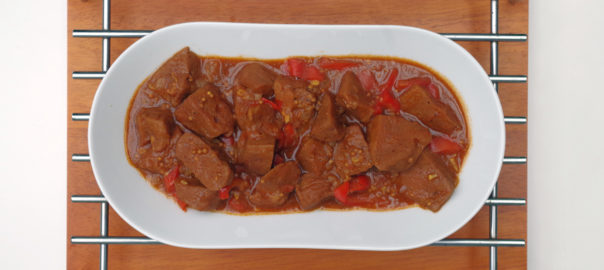Yoga Kitchen – Simple, healthy and vegan
Thousand year old source of plant protein
Have you switched to a vegan lifestyle and feel nostalgic for something like “meat stew”?
Then you must consider seitan.
Seitan has been known in oriental and more specifically Japanese cuisine for centuries. It is made by subjecting wheat flour to a series of consecutive rinsing procedures. The starch washes out and what remains is the wheat protein. Some people also make it from gluten powder. Gluten is the protein found in wheat and in plenty of other cereals. There is nothing wrong with that in itself. It is simply a powerful plant based source of protein.
Today, it is available in many forms as a standard meat substitute in organic shops and increasingly in other shops as well. Pre-cut in slices, in pieces or minced.
“Stoverij” is a typical Belgian (Flemish) dish people traditionally prepare with beer.
Seitan lends itself very well to this. But you can really do anything with it.
Take a look at this example of an oriental style spicy-sweet preparation:
For about two servings of vegan stew:
- 200 gr seitan “suprème” or ordinary seitan
- 50 gr onion
- 3 garlic cloves
- 150 gr red and/or yellow bell pepper
- 3 full tablespoons red madras curry paste (or any other curry paste of your choice)
- a teaspoon of cumin seed
- a teaspoon of mustard seeds
- 2 tablespoons tamari, or sea salt to taste
- 200 ml of water
- One tablespoon of wheat flour or spelt to thicken the sauce. Corn starch (maizena) or kuzu will do the trick just as well.
This is how to prepare:
Ready-to-use seitan does not require any pre-treatment. If it is a large piece of seitan, cut it into smaller pieces with a pair of scissors or a good knife.
- Chop the onion and garlic and cut the sweet bell pepper into pieces.
- Let a tablespoon of olive oil warm up in a pressure cooker or in an ordinary pan over a low heat.
- First sprinkle the herbs in the warm oil. The oil absorbs the flavours.
- Add onion and garlic and briefly fry.
- Stir in the pieces of seitan and fry briefly.
- Add the curry paste and the tamari and mix well.
- Add the bell pepper and mix with the seitan.
- Finally pour in the water, close the pan.
Irresistible
Preferably use a pressure cooker. This allows you to retain much more of the nutritional value. Also, the cooking process will take much less time and energy.
In a pressure cooker the whole thing is ready after about 15 minutes of simmering under steam pressure.
Count on 25 minutes for a classic pan.
Afterwards you can thicken the sauce by diluting the flour with some cooking liquid and then adding it to the preparation.
That’s it.
I guarantee you will be tempted to eat it all at once, it’s so tasty! The “suprème” version of seitan simply melts on the tongue.
Of course, nothing stops you from adding other vegetables or using other or additional herbs. Your taste is the norm.
Enjoy it fully !
Gluten or no gluten
Because more and more people are allergic to gluten, a phenomenon whose cause is exclusively attributed to gluten, eating wheat protein is more and more generally discouraged.
Personally, I think it is wrong. It is true that gluten, like other proteins, for example from animal origin, is relatively hard to digest. But if you are healthy and do not suffer from gluten intolerance, there is no reason to avoid it.
What is also true is that modern wheat has evolved genetically over the decades and is therefore no longer the same as the wheat that our ancestors knew. That may also have an impact on the digestibility of modern wheat. There are other cereals on sale in organic shops that are close to the structure and composition of the primeval wheat. Examples are kamut and spelt or emmer.
Thirdly, modern industrial bread is not as fair as the bread of yesteryear. For tasty, basic, fair bread you only need 4 ingredients:
- flour (ground cereal)
- water
- yeast or leaven
- (sea) salt
Modern industrial bread sometimes contains up to 20 different ingredients, mainly to make it leaven and ready to bake faster, and to influence its flavour and aroma.
Leaky gut
There is certainty that gluten, when it passes undigested or only partially undigested through the intestinal wall, cause damage further down the body, including allergic reactions.
On the other hand, there is no conclusive indication that the same gluten is also responsible for the deterioration and degeneration of the intestinal wall and the protective intestinal flora. For the latter may be due to other causes. Such as a diet that is too monotonous, with too many refined carbohydrates, too much added sugar, too many bad trans fats, too little fibre and, above all, industrially processed foods. The intestinal flora wears out, the intestinal wall slowly leaches out due to a lack of minerals and loses its protective effect: as a result too large openings appear. This is called “leaky gut” syndrome.
Read more about plant-based nutrition and health:
Read more articles about nutrition, health and plant-based foods:
Read more about plant-based food
Read more about yoga and yoga classes in Schaerbeek:
Check out our yoga classes here:


